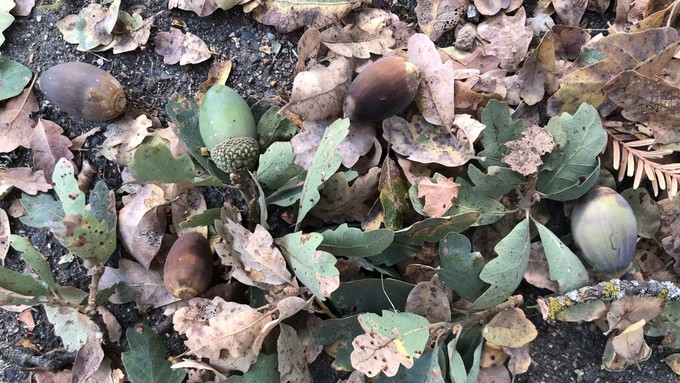
Sacramento Tree Foundation needs volunteers of all ages for gathering acorns

The annual acorn harvest celebrates the beginnings of the life cycle of native oaks. These are acorns and leaves from a blue oak, which is found on the edges of the Sacramento Valley and throughout the foothills. Kathy Morrison
It must be (almost) fall; the acorns are dropping.
Will it be a mast year with a bumper crop of acorns? (That could be a harbinger of a wet, cold winter.) Or will be oak fruit be hard to find?
Either way, the Sacramento Tree Foundation needs those tree nuts to grow a new crop of oaks to plant throughout the region and reforest habitat.
SacTree is hosting two Acorn Harvest Saturdays, Sept. 24 and Oct. 1. Each will be morning-long events, from 8:45 a.m. to noon, but in different locations. Sept 24 will concentrate on Folsom oaks. Oct 1 will harvest trees in Natomas. Specific locations will be provided at registration.
The annual acorn harvest is an important part of SacTree’s mission.
“At the Sacramento Tree Foundation, we steward our urban forest from seed to slab,” say the organizers. “The annual acorn harvest celebrates the beginnings of the life cycle of our native oaks. Acorns are harvested by volunteers, carefully sorted by interns, grown into seedlings by schoolchildren, planted at reforestation sites by volunteers, and stewarded by our staff.
“When trees reach the end of their lifespans, we salvage and sell their wood to further support education and programming around the life cycle of the urban forest.”
This crop of acorns will “grow the next generation of oak trees,” they added. “We provide all the necessary training and supplies to harvest acorns. Participants will receive a short hands-on training on site.
“Register now! The week before this event, we will send a logistics and directions email with detailed information about how to get to the site. You will receive this email only if you are signed up for this planting.
“Anyone but those who live or work nearby are especially encouraged to attend! This event is open to the general public, you do not need any prior experience to join us and on-site training will be provided. Families with children are welcome.”
Space is limited, SacTree adds. Volunteers under 18 years of age must have their parent or legal guardian sign their consent form during registration. Volunteers under 16 years of age must be accompanied and supervised by an adult. One adult chaperone is required for every six youths under age 16, or for every two children under 10.
Volunteers should wear long pants, long sleeves, closed-toe hiking boots or shoes, and sun protection. Dress comfortably and appropriately for the weather. Bring water. Contact with poison oak, ticks, snakes, bees or other wildland hazards is possible. Check in on time at 8:45 a.m. Volunteers must be present for the tool safety demonstration at the start of the event.
For details and registration: https://sactree.org/events/
– Debbie Arrington
Comments
0 comments have been posted.Sacramento Digs Gardening to your inbox.
Food in My Back Yard Series
April 29: What's (already) wrong with my tomato plants?
April 22: Should you stock up on fertilizer? (Yes!)
April 15: Grow culinary herbs in containers
April 8: When to plant summer vegetables
April 1: Don't be fooled by these garden myths
March 25: Fertilizer tips: How to 'feed' your vegetables for healthy growth
March 18: Time to give vegetable seedlings some more space
March 11: Ways to win the fight against weeds
March 4: Potatoes from the garden
Feb. 25: Plant a fruit tree now -- for later
Feb. 18: How to squeeze more food into less space
Feb. 11: When to plant? Consider staggering your transplants
Feb. 4: Starting in seed starting
Sites We Like
Garden Checklist for week of May 4
Enjoy this spring weather – and get gardening!
* Plant, plant, plant! It’s prime planting season in the Sacramento area. Time to set out those tomato transplants along with peppers and eggplants. Pinch off any flowers on new transplants to make them concentrate on establishing roots instead of setting premature fruit.
* Direct-seed melons, cucumbers, summer squash, corn, radishes, pumpkins and annual herbs such as basil.
* Harvest cabbage, lettuce, peas and green onions.
* In the flower garden, direct-seed sunflowers, cosmos, salvia, zinnias, marigolds, celosia and asters. (You also can transplant seedlings for many of the same flowers.)
* Plant dahlia tubers. Other perennials to set out include verbena, coreopsis, coneflower and astilbe.
* Transplant petunias, marigolds and perennial flowers such as astilbe, columbine, coneflowers, coreopsis, dahlias, rudbeckia and verbena.
* Keep an eye out for slugs, snails, earwigs and aphids that want to dine on tender new growth.
* Feed summer bloomers with a balanced fertilizer.
* For continued bloom, cut off spent flowers on roses as well as other flowering plants.
* Add mulch to the garden to maintain moisture. Mulch also cuts down on weeds. But don’t let it mound around the stems or trunks of trees or shrubs. Leave about a 6-inch to 1-foot circle to avoid crown rot or other problems.